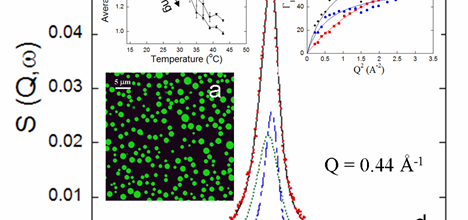The behaviour of the water and the design of the microsphere are key to providing such an environment. PVA/p(MA-co-NiPAAm) porous microgels are good candidates for controlled drug delivery since the volume of the microspheres depends upon temperature – so body temperature can be used as a trigger for drug delivery. Furthermore, the drug release properties are strongly dependent upon the diffusive behaviour of the water. It is therefore necessary to characterise how water diffuses within the microgel spheres using quasi-elastic neutron scattering (QENS) in order to evaluate the diffusion characteristics of the drug itself. QENS has allowed quantitative water diffusion rates to be determined above, and below, the volume phase transition in one particular thermo-responsive microgel.

(a) Confocal micrograph of microgels, (b) Microsphere diameter vs. temperature, (c) Diffusion of water (d) QENS experiment on hydrated microgels at room temperature: red dots, experimental data; black line, total fit; dashed blue line, polymer elastic.
Contact: Prof G Paradossi, paradossi@stc.uniroma2.it
SV Ghugare, E Chiessi, G Paradossi (Università di Roma Tor Vergata, Italy), MTF Telling (ISIS)
Research date: March 2009
Further Information
SV Ghugare et al., Biomacromolecules 10 (2009) 1589
